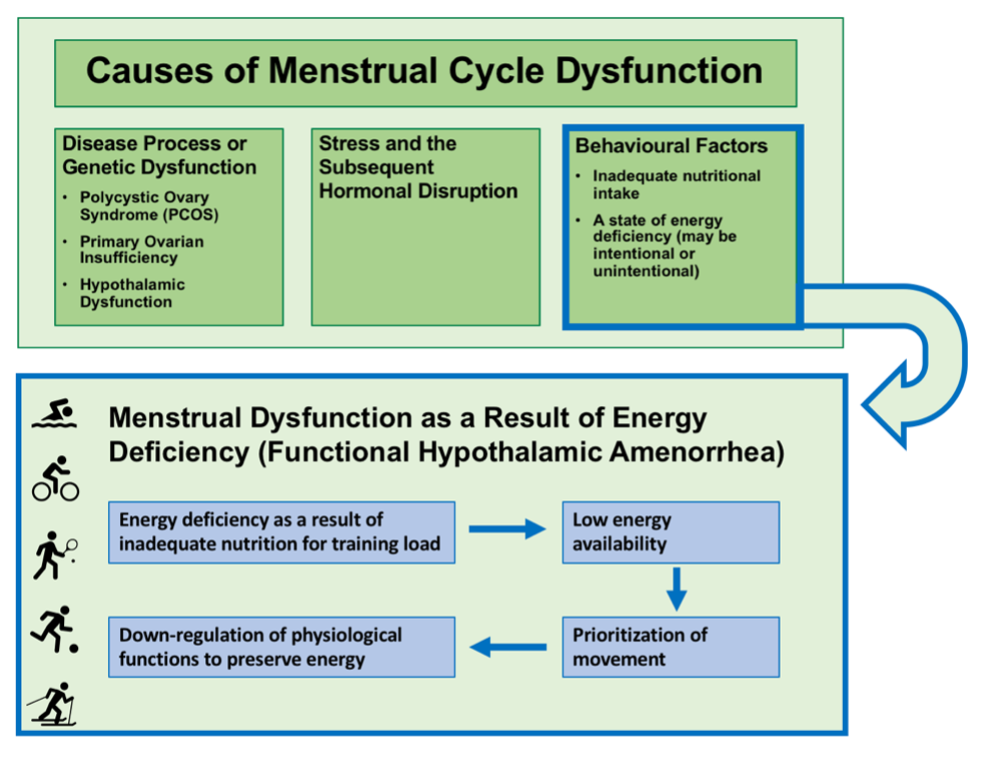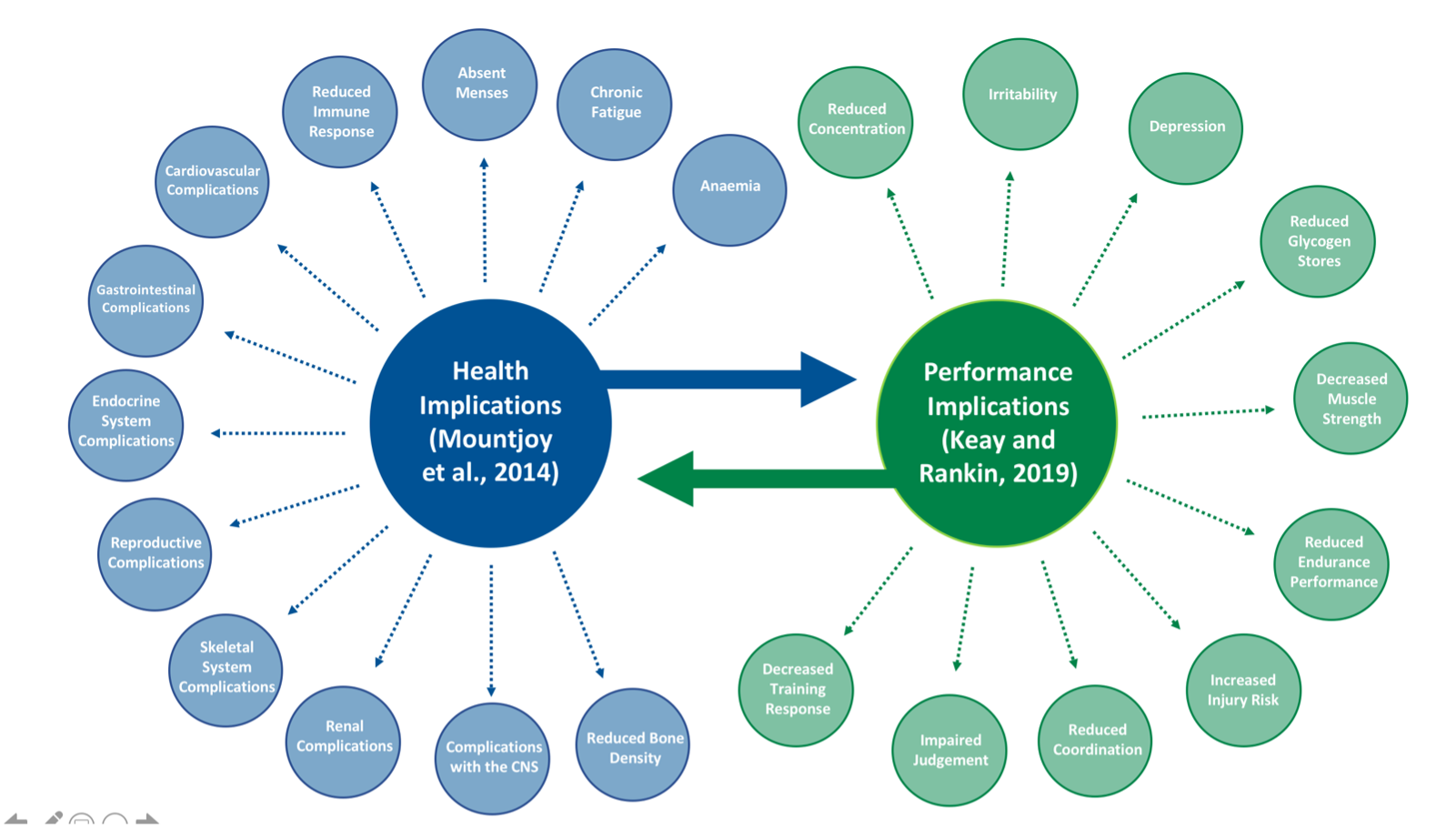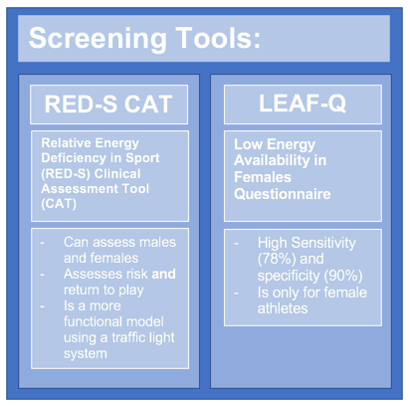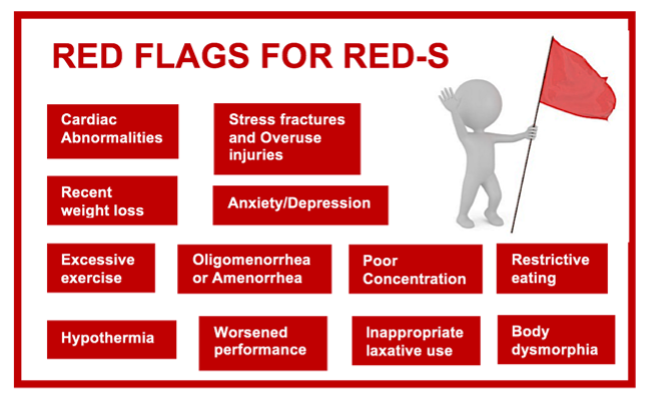Understanding the causes and clinical features of menstrual cycle dysfunctions
Menstrual cycle dysfunctions (MCDs) do not have one uniform definition or diagnostic criteria, and can be deconstructed into several presenting conditions. The most common of these involve alterations to cycle length and volume, presence of pain, and absence of ovulation. The discussion around Relative Energy Deficiency in Sport (RED-S) is growing, yet we, as healthcare professionals, continue to the mark both in the sporting and in the general population.
Types of MCD and their respective prevalence:


MCDs have many causal factors, the most prevalent of which are behavioural factors resulting in a state of energy deficiency, and subsequent functional hypothalamic amenorrhea (see image).
This is particularly prevalent in sports in which there is a weight category, such as lightweight rowing[8]. However, albeit an important conversation in sport, menstrual health may be a useful indicator of overall health. It may indicate the extent to which individuals are managing the physical and psychological demands of their lifestyles[9]. Assessing for RED-S should therefore not be limited to sporting participants, as the laywoman is not exempt from this state of energy deficiency and subsequent hormonal disruption.10 [10]11[11]
The Health and Performance Implications of RED-S

What can we as healthcare professionals do?
- Screen: Consider history of menstrual cycle function in initial subjective assessments, and consider the use of screening tools:
- Do not ignore red flags in non-sporting participants: functional hypothalamic amenorrhea is not limited to athletes
- Know when to refer on: Imaging, dietetics, clinical psychology
Conclusion:
- MCDs are present in all populations, and not limited to sporting participants, as we are led to believe by the term Relative Energy Deficiency in Sport
- Early recognition is essential to limit the disastrous impacts on performance, recovery and injury rates
- HCPs should be more open to discussing the menstrual cycle, and to using MCD as a red flag for functional hypothalamic amenorrhea

Key take-away
RED-S, the updated model of the female athlete triad, has correctly identified that both men and women may be susceptible to the detrimental effects of prolonged energy deficiency, however, it has created a narrative that these may only present in sporting participants. MCDs in any woman provide a red flag that their nutritional intake is insufficient for their current activity level or lifestyle, thus putting their health and performance at significant risk. Such significant findings highlight the need to consider menstrual health in subjective assessments in order to provide holistic and preventive care.
Author and Affiliations
Catherine Stanislas
Physiotherapist at Isokinetic Medical Centre, Harley Street
LinkedIn: https://www.linkedin.com/in/katie-stanislas-clms/
References
[1] Miller K, Kibanski K. Amenorrheic Bone Loss. The Journal of Clinical Endocrinology & Metabolism. 1999;84(6):1775–1783.
[2] Gibbs J, Williams N, De Souza M. Prevalence of Individual and Combined Components of the Female Athlete Triad. Medicine and Science in Sports and Exercise. 2013;45(5):985-96.
[3] Samani R, Hashiani A, Razavi M et al. The Prevalence of Menstrual Disorders in Iran: A Systematic Review and Meta-Analysis. International Journal of Reproductive BioMedicine. 2018;16(11): 665-678
[4] Nooh A, Abdul-Hady A, El-Attar N. Nature and Prevalence of Menstrual Disorders Among Teenage Female Students at Zagazig University, Zagazig, Egypt. Journal of Paediatric and Adolescent Gynaecology. 2016;29(2):137-142
[5] Patel V, Tanksale V, Sahasrabhojanee M. The Burden and Determinants of Dysmenorrhea: A Population-Based Survey of 2262 Women in Goa, India. An International Journal of Obstetrics and Gynaecology (BJOG). 2006;113(4): 453-463
[6] Latthe P, Latthe M, Say L et al. WHO Systematic Review of Prevalence of Chronic Pelvic Pain: a Neglected Reproductive Health Morbidity. BMC Public Health. 2006;6:177
[7] Lynch K, Mumford S, Schliep K et al. Assessment of Anovulation in Eumenorrheic Women: Comparison of Ovulation Detection Algorithms. Fertility and Sterility. 2015;102(2):511-518
[8] Gillbanks L, Mountjoy M, Filbay S. Insufficient Knowledge and Inappropriate Physiotherapy Management of Relative Energy Deficiency in Sport (RED-S) in Lightweight Rowers. Physical Therapy in Sport. 2022; 54(22):8-15
[9] Harber V. The Young Female Athlete: Using the Menstrual Cycle as a Navigational Beacon for Healthy Development. Canadian Journal for Women in Coaching. 2011;11(3)
[10] Mountjoy M, Sundgot-Borgen J, Burke L et al. The IOC Consensus Statement: Beyond the Female Athlete Triad – Relative Energy Deficiency in Sport (RED-S). British Journal of Sports Medicine. 2014;48(7)
[11] Keay N, Rankin A. Infographic. Relative Energy Deficiency in Sport: An Infographic Guide. British Journal of Sport Medicine. 2019;50(20).
[12] Melin A, Department of Nutrition, Exercise and Sports, University of Copenhagen. The LEAF-Q. A Questionnaire for Female Athletes. 2013.